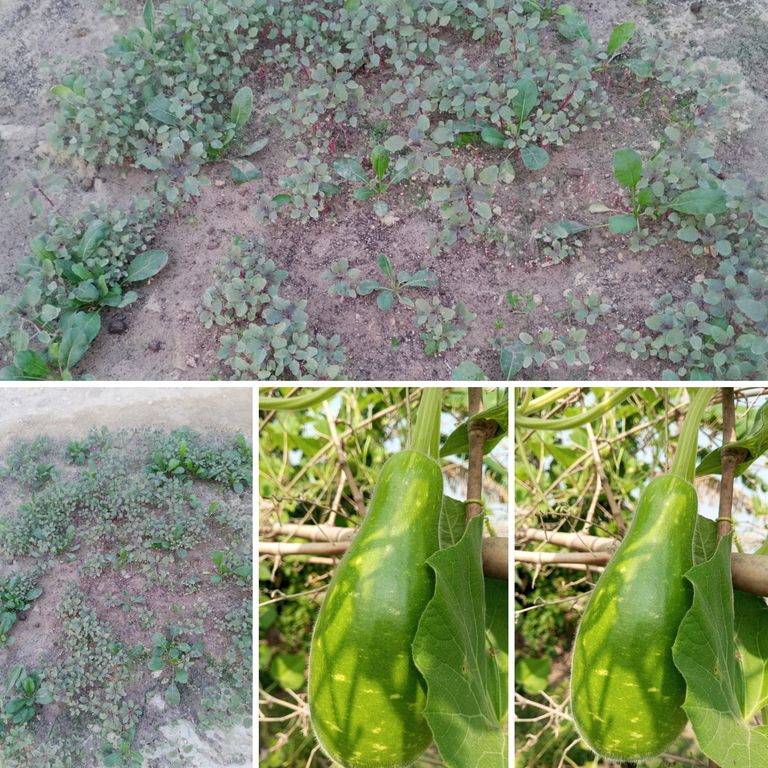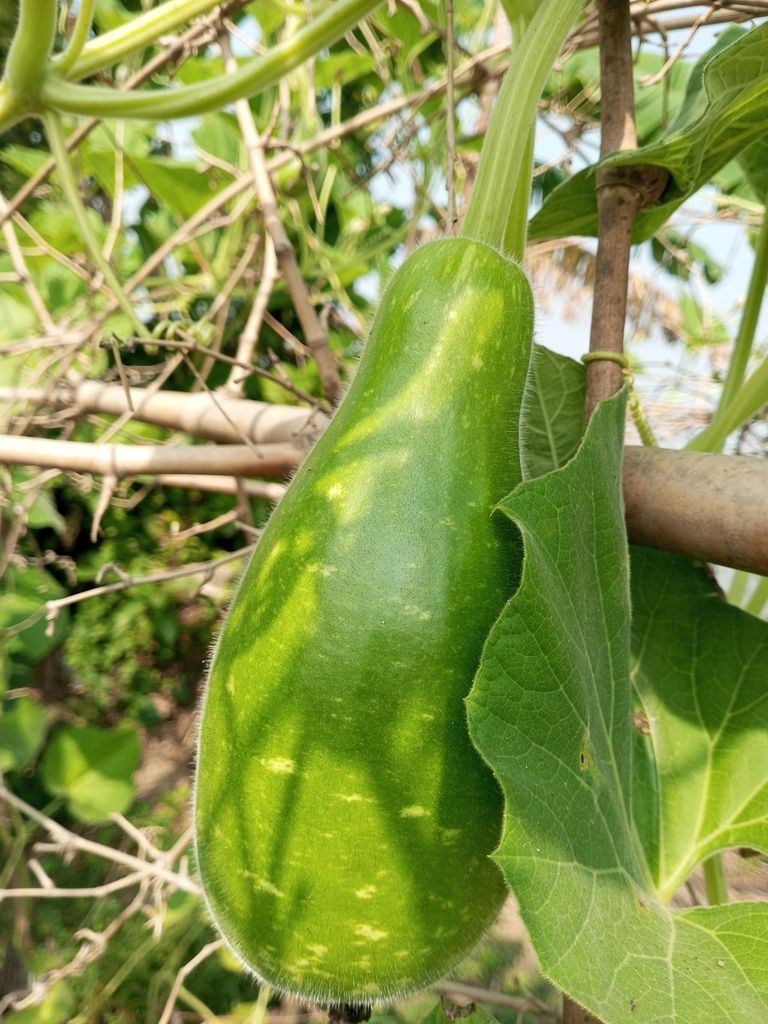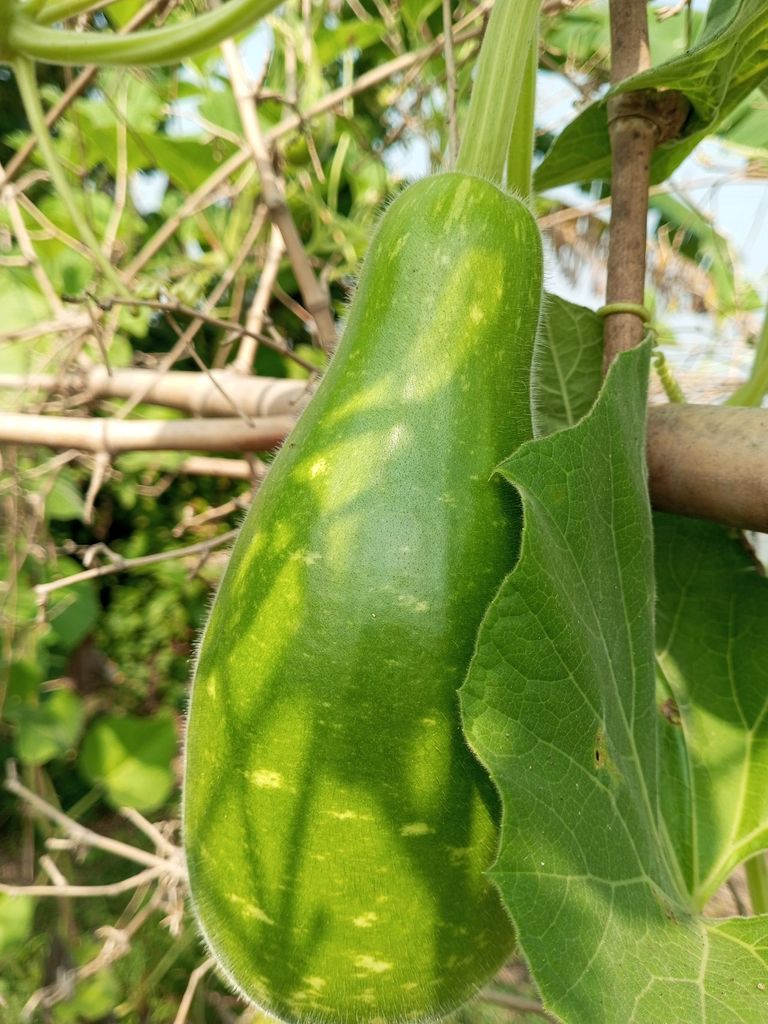

Gourd is a popular vegetable that is on the menu in almost every Bengali household. Apart from being tasty, light and nutritious, it also provides various health benefits. Gourds are usually abundant in summer and monsoon and can be easily cultivated in home gardens or fields. In this blog we will discuss in detail about gourd nutrition, health benefits, and its cultivation method.
Nutritional value of gourd
Gourd is a vegetable that is rich in many nutrients. It is low in calories and rich in most water content. 100 grams of gourd contains about 90-95% water, which helps in keeping the body hydrated. It also contains various essential vitamins and minerals.
Key Nutrients of Gourd:
Calories: Gourd contains about 15-18 calories, making it a low-calorie food.
Protein: 100 grams of gourd contains about 0.6 grams of protein.
Sugars: Gourd contains about 3.3 grams of sugars.
Fiber: Gourd is rich in fiber, which helps improve digestion.
Vitamin C: Gourd is rich in vitamin C, which boosts immunity.
Potassium: Gourds are high in potassium, which helps regulate blood pressure.
Health Benefits of Gourd
The various nutrients in gourds provide various benefits to the body. Below are some important health benefits of gourd:
- Helps in weight loss
Gourd is a low calorie food, which is very useful for weight loss. It is rich in water and fiber, which keeps the stomach full for longer and reduces the tendency to overeat. Moreover, it helps in improving the metabolism of the body, which helps to burn calories faster.
- Improves digestion
Fiber in gourd helps in digestion. It relieves constipation and reduces stomach discomfort. Also, since gourd is light, it is easily digested and prevents stomach problems.
- Reduces the risk of heart disease
The presence of potassium in gourd is beneficial for the heart. It is helpful in controlling blood pressure and helps in reducing bad cholesterol. This reduces the risk of heart disease and keeps the heart healthy.
- Increases immunity
Vitamin C present in gourd helps to increase the immunity of the body. It is helpful in preventing the attack of various viruses and bacteria. Regular consumption of gourd provides protection against diseases like cold, flu and fever.
- Helpful in skin care
Antioxidants in gourd protect the skin from the harmful effects of free radicals. It reduces skin wrinkles and helps keep the skin glowing and smooth.
- Helpful in controlling diabetes
Due to the low sugar content in gourd, it is beneficial for diabetics. It helps control blood sugar levels and increases insulin sensitivity.
- Helpful in urinary problems
Gourd acts as a natural diuretic, which helps in curing urinary problems. It helps flush out toxins from the body through urine and improves kidney function.
লাউ একটি জনপ্রিয় সবজি যা প্রায় প্রতিটি বাঙালি পরিবারেই খাবারের তালিকায় থাকে। এটি সুস্বাদু, হালকা ও পুষ্টিকর হওয়ার পাশাপাশি নানা ধরনের স্বাস্থ্য উপকারিতাও প্রদান করে। লাউ সাধারণত গ্রীষ্ম ও বর্ষাকালে বেশি পাওয়া যায় এবং এটি খুব সহজেই বাড়ির বাগান বা মাঠে চাষ করা যায়। এই ব্লগে আমরা লাউয়ের পুষ্টিগুণ, স্বাস্থ্য উপকারিতা, এবং এর চাষাবাদ পদ্ধতি সম্পর্কে বিস্তারিত আলোচনা করব।
লাউয়ের পুষ্টিগুণ
লাউ এমন একটি সবজি যা অনেক পুষ্টি উপাদানে সমৃদ্ধ। এটি কম ক্যালোরিযুক্ত এবং অধিকাংশ জলের পরিমাণে সমৃদ্ধ। ১০০ গ্রাম লাউয়ে প্রায় ৯০-৯৫% পানি থাকে, যা শরীরকে হাইড্রেটেড রাখতে সহায়ক। এছাড়াও এতে বিভিন্ন প্রয়োজনীয় ভিটামিন ও খনিজ পদার্থ পাওয়া যায়।
লাউয়ের স্বাস্থ্য উপকারিতা
লাউয়ে থাকা বিভিন্ন পুষ্টি উপাদান শরীরের জন্য নানা ধরনের উপকার নিয়ে আসে। নিচে লাউয়ের কিছু গুরুত্বপূর্ণ স্বাস্থ্য উপকারিতা তুলে ধরা হলো:
১. ওজন কমাতে সহায়ক
লাউ একটি কম ক্যালোরিযুক্ত খাদ্য, যা ওজন কমানোর জন্য অত্যন্ত উপযোগী। এতে প্রচুর পরিমাণে পানি ও ফাইবার রয়েছে, যা পেট অনেকক্ষণ পর্যন্ত ভরা রাখে এবং অতিরিক্ত খাবার খাওয়ার প্রবণতা কমায়। তাছাড়া, এটি শরীরের বিপাকক্রিয়া উন্নত করতে সহায়ক, যা দ্রুত ক্যালোরি পোড়াতে সহায়ক।
২. হজমশক্তি উন্নত করে
লাউয়ে থাকা ফাইবার হজমশক্তি বাড়াতে সাহায্য করে। এটি কোষ্ঠকাঠিন্য দূর করে এবং পেটের অস্বস্তি কমায়। এছাড়াও, লাউ হালকা হওয়ায় এটি সহজেই হজম হয় এবং পেটের সমস্যা প্রতিরোধ করে।
৩. হৃদরোগের ঝুঁকি কমায়
লাউয়ে পটাশিয়ামের উপস্থিতি হৃদযন্ত্রের জন্য উপকারী। এটি রক্তচাপ নিয়ন্ত্রণে সহায়ক এবং খারাপ কোলেস্টেরল কমাতে সাহায্য করে। এর ফলে হৃদরোগের ঝুঁকি কমে যায় এবং হৃদযন্ত্র সুস্থ থাকে।
৪. রোগ প্রতিরোধ ক্ষমতা বাড়ায়
লাউয়ে থাকা ভিটামিন সি শরীরের রোগ প্রতিরোধ ক্ষমতা বাড়াতে সাহায্য করে। এটি বিভিন্ন ভাইরাস ও ব্যাকটেরিয়ার আক্রমণ প্রতিরোধ করতে সহায়ক। নিয়মিত লাউ খেলে ঠান্ডা, সর্দি ও জ্বরের মতো রোগ থেকে সুরক্ষা পাওয়া যায়।
৫. ত্বকের যত্নে সহায়ক
লাউয়ের মধ্যে থাকা অ্যান্টিঅক্সিডেন্ট ত্বককে ফ্রি র্যাডিক্যালের ক্ষতিকর প্রভাব থেকে রক্ষা করে। এটি ত্বকের বলিরেখা কমায় এবং ত্বককে উজ্জ্বল ও মসৃণ রাখতে সহায়ক।
৬. ডায়াবেটিস নিয়ন্ত্রণে সহায়ক
লাউয়ে শর্করার পরিমাণ কম থাকায় এটি ডায়াবেটিস রোগীদের জন্য উপকারী। এটি রক্তে শর্করার মাত্রা নিয়ন্ত্রণ করতে সহায়ক এবং ইনসুলিন সংবেদনশীলতা বাড়ায়।
৭. ইউরিনারি সমস্যায় সহায়ক
লাউ একটি প্রাকৃতিক ডায়ুরেটিক হিসেবে কাজ করে, যা মূত্র সংক্রান্ত সমস্যা দূর করতে সহায়ক। এটি প্রস্রাবের মাধ্যমে শরীর থেকে টক্সিন বের করতে সাহায্য করে এবং কিডনির কার্যকারিতা উন্নত করে।

Cultivation method of gourd
Gourd cultivation is a simple and profitable process. It can be grown in backyards, rooftops or commercially in fields at low cost. Gourd grows best in summer and monsoon, but with proper care it can be cultivated almost all year round.
Steps required for Gourd Cultivation:
- Soil selection
Fertile loam or sandy-loam soil is suitable for gourds. Soil pH should be between 5.5 and 6.8. For good yield of gourd, there should be drainage system in the soil, so that excess water does not accumulate.
- land preparation
To grow gourd, first the land should be cultivated well. Necessary organic fertilizers and chemical fertilizers should be applied during land preparation. Farms or lofts can be created after the land is cultivated, so that the gourd plant does not come in contact with the soil and the yield is better.
- Sowing seeds and seedlings
Gourd seeds can be sown directly in the ground, or seedlings can be planted in the ground. It takes 1-2 weeks to produce seedlings from seed. Seedlings should be planted at a distance of 20-30 cm, so that the plants get enough light and air.
- Irrigation system
Gourd plants require regular irrigation. First, after sowing the seeds, water should be given before the soil dries up. Irrigation should be done every 7-10 days if the plant is big. If excess water accumulates during monsoon, water drainage should be arranged.
- Fertilizer application
Gourd plants need regular fertilization. First, organic fertilizers should be applied to the land at the time of sowing. Later urea, TSP, and MOP fertilizers can be applied every 20-25 days. Besides, application of phosphorus and potassium fertilizers also gives good yield.
- weed control
When weeds grow around gourd plants, they must be cleared quickly, as weeds absorb nutrients and inhibit plant growth. Weeds should be controlled by regular tillage.
- loft made
As the gourd plant is creeping in nature, it is necessary to make a loft. By creating a loft, the plant grows faster without coming into contact with the soil and yields better. Bamboo, wood or iron poles can be used to build the loft.
- Pest and pest control
Gourds are often affected by some insects and diseases, such as leafhoppers, fruit flies, downy mildew, etc. For this, pesticides should be used regularly and the health of the plants should be monitored. Neem oil or other natural insecticides can be used for pest control in organic systems.
Commercial potential of gourd
Gourd cultivation can be a commercially profitable venture. It can be cultivated at relatively low cost and can be sold at a good price in the market if the yield is good. Moreover, due to its high nutritional value and health benefits, gourd is an essential vegetable in the human diet. Successful cultivation of gourd can be achieved through proper care and irrigation system.

Red cabbage is a very popular vegetable of Bangladesh. Its bright red color and taste fascinates people. Red leafy vegetables are not only delicious but also contain a variety of nutrients that are extremely beneficial for the body. It can be grown in the home garden or commercially and is a favorite among the nutrition and health conscious. In this blog we will discuss the nutritional value of red cabbage, its health benefits and cultivation methods.
Nutritional value of red vegetables
Kale is a vegetable rich in vitamins, minerals, and antioxidants. By eating it, various nutrients needed by the body are easily available. It is also very useful as a diet food as it is low in calories.
Nutrients of Red Vegetables:
Calories: As kale is low in calories, it is an ideal food for health conscious people.
Protein: It is a good source of protein, which helps in building and developing the body.
Iron: Red leafy vegetables are rich in iron, which helps in the production of hemoglobin in the blood.
Vitamin A: Vitamin A in it is helpful in improving eyesight and skin care.
Vitamin C: Red leafy vegetables are an excellent source of vitamin C, which boosts the immune system.
Calcium: It helps in maintaining strong bone and teeth structure.
Health benefits of red vegetables
The nutrients in red vegetables provide a variety of benefits to the body. It not only enhances the taste of food but also has many health benefits. Below are some of the major health benefits of red leafy vegetables:
- Eliminates anemia
Red cabbage is rich in iron, which increases the production of hemoglobin in the blood and prevents anemia. Anemia is a common problem especially among women, which can be eliminated by consuming red vegetables regularly.
- Helpful in eye care
Vitamin A in red vegetables is very beneficial for eyes. It improves eyesight and reduces the risk of cataracts or other eye problems. It is possible to take care of eyes by eating red vegetables regularly.
- Increases immunity
Vitamin C present in red vegetables helps to increase the immune system of the body. It builds immunity against cold, cough and other common diseases. Besides, vitamin C prevents cell damage in the body and improves skin health.
- Helpful in bone and teeth care
Red leafy vegetables are rich in calcium, which helps in maintaining strong bone and tooth structure. It is especially beneficial for the elderly, as bone density decreases with age and bones become weaker. Eating red vegetables regularly can prevent bone loss.
- Improves digestion
Kale is rich in fiber, which helps improve digestion. It prevents constipation and solves stomach problems. Eating red vegetables regularly keeps the digestive system healthy and the digestion process is done smoothly.
- Helpful in controlling blood pressure
Potassium in red leafy vegetables is helpful in controlling blood pressure. It reduces the pressure on the blood vessels and reduces the risk of high blood pressure. For those suffering from high blood pressure, red vegetables can be an ideal food.
- Helps in weight loss
As kale is low in calories and high in fiber, it helps in weight loss. It keeps the stomach full and reduces hunger pangs, thereby reducing the risk of overeating. Those who are on a diet should include red vegetables in their diet.
লাল শাক বাংলাদেশের একটি অত্যন্ত জনপ্রিয় সবজি। এর উজ্জ্বল লাল রঙ ও স্বাদ মানুষকে মুগ্ধ করে। লাল শাক শুধুমাত্র সুস্বাদু নয়, এতে রয়েছে বিভিন্ন ধরনের পুষ্টিগুণ যা শরীরের জন্য অত্যন্ত উপকারী। এটি বাড়ির আঙ্গিনায় বা বাণিজ্যিকভাবে চাষ করা যায় এবং পুষ্টি ও স্বাস্থ্য সচেতনদের কাছে বিশেষভাবে প্রিয়। এই ব্লগে আমরা লাল শাকের পুষ্টিগুণ, এর স্বাস্থ্য উপকারিতা এবং চাষাবাদ পদ্ধতি নিয়ে আলোচনা করব।
লাল শাকের পুষ্টিগুণ
লাল শাক ভিটামিন, খনিজ, এবং অ্যান্টিঅক্সিডেন্টে সমৃদ্ধ একটি সবজি। এটি খেলে শরীরের জন্য প্রয়োজনীয় বিভিন্ন পুষ্টি উপাদান সহজেই পাওয়া যায়। এতে ক্যালোরি কম থাকায় এটি ডায়েট খাদ্য হিসেবেও অত্যন্ত উপযোগী।
লাল শাকের পুষ্টি উপাদান:
ক্যালোরি: লাল শাকে ক্যালোরি কম থাকায় এটি স্বাস্থ্য সচেতন ব্যক্তিদের জন্য আদর্শ খাদ্য।
প্রোটিন: এটি প্রোটিনের একটি ভালো উৎস, যা শরীরের গঠন ও বিকাশে সহায়ক।
আয়রন: লাল শাক আয়রনে সমৃদ্ধ, যা রক্তের হিমোগ্লোবিন উৎপাদনে সহায়তা করে।
ভিটামিন এ: এতে থাকা ভিটামিন এ চোখের দৃষ্টিশক্তি বাড়াতে এবং ত্বকের যত্নে সহায়ক।
ভিটামিন সি: লাল শাক ভিটামিন সি-এর একটি চমৎকার উৎস, যা রোগ প্রতিরোধ ক্ষমতা বৃদ্ধি করে।
ক্যালসিয়াম: এটি হাড় ও দাঁতের গঠন মজবুত রাখতে সহায়ক।
লাল শাকের স্বাস্থ্য উপকারিতা
লাল শাকের মধ্যে থাকা পুষ্টি উপাদান শরীরের বিভিন্ন ধরনের উপকার করে। এটি শুধু খাবারের স্বাদ বাড়ায় না, বরং এর অনেকগুলো স্বাস্থ্য উপকারিতাও রয়েছে। নিচে লাল শাকের কিছু প্রধান স্বাস্থ্য উপকারিতা তুলে ধরা হলো:
১. রক্তস্বল্পতা দূর করে
লাল শাকে প্রচুর পরিমাণে আয়রন রয়েছে, যা রক্তের হিমোগ্লোবিন উৎপাদন বাড়ায় এবং রক্তস্বল্পতা প্রতিরোধ করে। বিশেষ করে মহিলাদের মধ্যে রক্তস্বল্পতা বা অ্যানিমিয়া একটি সাধারণ সমস্যা, যা নিয়মিত লাল শাক খেলে দূর করা সম্ভব।
২. চোখের যত্নে সহায়ক
লাল শাকে থাকা ভিটামিন এ চোখের জন্য অত্যন্ত উপকারী। এটি দৃষ্টিশক্তি বাড়ায় এবং রাতকানা বা অন্যান্য চোখের সমস্যার ঝুঁকি কমায়। নিয়মিত লাল শাক খেলে চোখের যত্ন নেওয়া সম্ভব।
৩. রোগ প্রতিরোধ ক্ষমতা বাড়ায়
লাল শাকে থাকা ভিটামিন সি শরীরের রোগ প্রতিরোধ ক্ষমতা বাড়াতে সহায়ক। এটি সর্দি, কাশি এবং অন্যান্য সাধারণ রোগের বিরুদ্ধে প্রতিরোধ গড়ে তোলে। এছাড়া, ভিটামিন সি শরীরের কোষের ক্ষয় প্রতিরোধ করে এবং ত্বকের স্বাস্থ্য উন্নত করে।
৪. হাড় ও দাঁতের যত্নে সহায়ক
লাল শাক ক্যালসিয়ামে সমৃদ্ধ, যা হাড় ও দাঁতের গঠন মজবুত রাখতে সহায়ক। এটি বয়স্কদের জন্য বিশেষভাবে উপকারী, কারণ বয়স বাড়ার সঙ্গে সঙ্গে হাড়ের ঘনত্ব কমে যায় এবং হাড় দুর্বল হয়ে পড়ে। নিয়মিত লাল শাক খেলে হাড়ের ক্ষয় প্রতিরোধ করা যায়।
৫. হজমশক্তি উন্নত করে
লাল শাকে প্রচুর পরিমাণে ফাইবার বা আঁশ থাকে, যা হজমশক্তি উন্নত করতে সহায়ক। এটি কোষ্ঠকাঠিন্য প্রতিরোধ করে এবং পেটের সমস্যার সমাধান করে। নিয়মিত লাল শাক খেলে পরিপাকতন্ত্র সুস্থ থাকে এবং হজম প্রক্রিয়া সুষ্ঠুভাবে সম্পন্ন হয়।
৬. রক্তচাপ নিয়ন্ত্রণে সহায়ক
লাল শাকে থাকা পটাশিয়াম রক্তচাপ নিয়ন্ত্রণে সহায়ক। এটি রক্তনালীগুলোর চাপ কমায় এবং উচ্চ রক্তচাপের ঝুঁকি হ্রাস করে। যারা উচ্চ রক্তচাপে ভুগছেন, তাদের জন্য লাল শাক একটি আদর্শ খাদ্য হতে পারে।
৭. ওজন কমাতে সহায়ক
লাল শাকে ক্যালোরি কম এবং ফাইবার বেশি থাকায় এটি ওজন কমাতে সহায়ক। এটি পেট ভরিয়ে রাখে এবং ক্ষুধার প্রবণতা কমায়, ফলে অতিরিক্ত খাওয়ার ঝুঁকি হ্রাস পায়। যারা ডায়েট করছেন, তাদের খাদ্যতালিকায় লাল শাক অন্তর্ভুক্ত করা উচিত।

Cultivation method of red vegetables
Cabbage is a fast-growing vegetable that can be grown at low cost and with simple methods. It can be grown in backyards, rooftops or commercially in fields. Red cabbage does not require any special care. But if it is cultivated in the right way, its yield can be very high.
Steps of Red Cabbage Cultivation:
- Soil selection and land preparation
Loam or sandy-loam soil is best for red cabbage. The soil should be clean and fertile. Before planting organic manure should be added to the soil and the land should be plowed well so that the soil is soft and suitable for sowing.
- sowing seeds
Red cabbage is usually cultivated by direct sowing. The seeds should be sown at a distance of 10-12 inches, so that the plants grow evenly. After sowing the seeds, lightly water the soil so that the seeds grow properly.
- Irrigation system
Lettuce plants grow quickly, so regular irrigation is required early on. When the soil is dry, it should be irrigated again, but excess water should not be allowed to accumulate. There should be drainage system during rain.
- Fertilizer application
Red leafy vegetables need adequate nutrients in the soil. Organic fertilizers should be applied to the land before sowing. Then when the seedlings grow, apply urea, TSP and MOP fertilizers as required. Applying the right amount of fertilizer will speed up the growth of red cabbage and increase the yield.
- weed control
In the case of red vegetable cultivation, if weeds grow in the land, they must be cleaned quickly. Weeds absorb nutrients and inhibit plant growth. So the land should be cleaned regularly.
- Pest and pest control
Red cabbage can be attacked by some common insects and diseases, such as leafhoppers, mealybugs, etc. Pesticides can be used as needed to control insects. Besides, insects can also be controlled organically using neem oil or other natural pesticides.
- harvest
Cabbage seeds are ready to harvest around 25-30 days after sowing. When the plants reach a height of 8-12 inches, they can be cut. However, if it is allowed to grow too much, the taste of the vegetable may decrease.
Commercial potential of red vegetables
Lettuce is a short duration crop, which yields in a short period of time. It can be cultivated commercially to earn good profits. Moreover, the demand for red vegetables is almost year-round. With proper care and pest control, it is possible to grow commercial lettuce successfully.